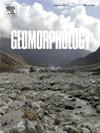Chemical characterization and causes of differences in surface sediments of sand dunes in northern China under wind-water composite effects – A case study of the Kubuqi Desert
IF 3.1
2区 地球科学
Q2 GEOGRAPHY, PHYSICAL
引用次数: 0
Abstract
Sediments comprise the base material for the development of wind-driven sand-based landscapes, and dune deposits contain fundamental information regarding the processes of dune formation and development. This study analyzed the surface sediments of seven different types of sand dunes in the Kubuqi Desert (China) from the perspectives of mineralogy, elemental geochemistry, and sedimentology. Results showed that the light mineral composition of Kubuqi Desert sediments is dominated by quartz, and feldspar, and that the overall maturity index is high. The chemical macronutrient composition is dominated by SiO₂ and Al₂O₃, and the trace elements are dominated by Cr and Zr. Analysis of elements based on the normalized average chemical composition of the upper continental crust revealed enrichment in Si and Cr. The characteristics of Kubuqi Desert sediments indicate moderate–low chemical weathering (the average Chemical Index of Alteration value is 55.97), representing relatively stable sediments formed under dry cold conditions that are in the early stage of chemical weathering. Parabolic dunes, together with central and eastern shrub-coppice dunes, were found to be the most weathered. Flood alluviation and wind transport jointly promote the weathering process of Kubuqi Desert sediments, resulting in ridge–honeycomb dunes and reticulate dune chains that do not have a unique source. Conversely, compound dunes and some crescent dunes and chains were found to have a common source of material. The findings of this study could provide a basic reference for analysis of desert material sources, inversion of dune formation and development processes, and reconstruction of ancient aeolian environments.
风-水复合作用下中国北方沙丘表层沉积物化学特征及差异成因——以库布其沙漠为例
沉积物是风沙地貌形成的基础物质,沙丘沉积物包含了沙丘形成和发展过程的基本信息。本文从矿物学、元素地球化学和沉积学等方面对库布其沙漠7种不同类型沙丘的表层沉积物进行了分析。结果表明:库布其沙漠沉积物轻矿物组成以石英、长石为主,整体成熟度指数较高;化学常量营养成分以SiO₂和Al₂O₃为主,微量元素以Cr和Zr为主。上陆壳归一化平均化学成分元素分析显示Si、Cr富集。库布其沙漠沉积物具有中-低化学风化特征(平均蚀变指数为55.97),在干冷条件下形成相对稳定的沉积物,处于化学风化的早期阶段。抛物线形沙丘以及中部和东部灌木-灌木林沙丘的风化程度最高。洪水冲积和风输运共同促进了库布其沙漠沉积物的风化过程,形成了没有唯一来源的脊-蜂窝沙丘和网状沙丘链。相反,复合沙丘和一些新月形沙丘和链状沙丘被发现具有共同的物质来源。研究结果可为沙漠物质来源分析、沙丘形成发育过程反演、古风成环境重建等提供基础参考。
本文章由计算机程序翻译,如有差异,请以英文原文为准。
求助全文
约1分钟内获得全文
求助全文
来源期刊

Geomorphology
地学-地球科学综合
CiteScore
8.00
自引率
10.30%
发文量
309
审稿时长
3.4 months
期刊介绍:
Our journal''s scope includes geomorphic themes of: tectonics and regional structure; glacial processes and landforms; fluvial sequences, Quaternary environmental change and dating; fluvial processes and landforms; mass movement, slopes and periglacial processes; hillslopes and soil erosion; weathering, karst and soils; aeolian processes and landforms, coastal dunes and arid environments; coastal and marine processes, estuaries and lakes; modelling, theoretical and quantitative geomorphology; DEM, GIS and remote sensing methods and applications; hazards, applied and planetary geomorphology; and volcanics.
 求助内容:
求助内容: 应助结果提醒方式:
应助结果提醒方式:


